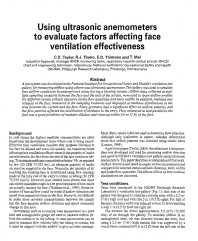Mining Publication: Using Ultrasonic Anemometers to Evaluate Factors Affecting Face Ventilation Effectiveness
Original creation date: February 2005
A test system was developed at the National Institute for Occupational Safety and Health's ventilation test gallery for measuring airflow using a three-axis ultrasonic anemometer. The gallery was used to simulate face airflow conditions in underground mines having a blowing curtain. Airflow data, collected at multiple sampling locations between the face and the end of the curtain, were used to draw airflow profiles for different curtain setback distances, intake flow quantities, and entry widths. In addition, methane was released at the face, measured at the sampling locations, and displayed as methane distributions in the areas between the curtain and the face. Entry geometry had a significant effect on airflow patterns, and the flow patterns affected the distribution of methane in the entry. Flow measured at and parallel to the face was a good predictor of methane dilution and removal within 0.6m (2 ft) of the face.
Authors: CD Taylor, RJ Timko, ED Thimons, T Mal
Peer Reviewed Journal Article - January 2006
NIOSHTIC2 Number: 20032625
Trans Soc Min Metall Explor 2006 Jan; 320:127-132
Conference Paper - February 2005
NIOSHTIC2 Number: 20026391
2005 SME Annual Meeting, February 28 - March 2, Salt Lake City, Utah, preprint 05-80. Littleton, CO, Society for Mining, Metallurgy, and Exploration, Inc., 2005 Feb; :1-7
See Also
- Atmospheric Monitoring
- CO and CO2 Emissions from Spontaneous Heating of Coal Under Different Ventilation Rates
- Experimental and Modeling Investigation of the Effect of Ventilation on Smoke Rollback in a Mine Entry
- Investigation into the Practical Use of Belt Air at US Longwall Operations
- Measurement of Airflow in a Simulated Underground Mine Environment Using an Ultrasonic Anemometer
- Novel Stopping Designs for Large-Opening Metal/Nonmetal Mines
- Sonic Anemometer Airflow Monitoring Technique for Use in Underground Mines
- Sulfur Hexafluoride as a Mine Ventilation Research Tool - Recent Field Applications
- Technology News 519 - EZ-Up Curtain Stoppings: A Practical Solution for Directing Ventilation Airflows in Large-opening Metal/Nonmetal Mines
- Using Ultrasonic Anemometers to Evaluate Face Ventilation Conditions
- Page last reviewed: 9/21/2012
- Page last updated: 9/21/2012
- Content source: National Institute for Occupational Safety and Health, Mining Program


 ShareCompartir
ShareCompartir
